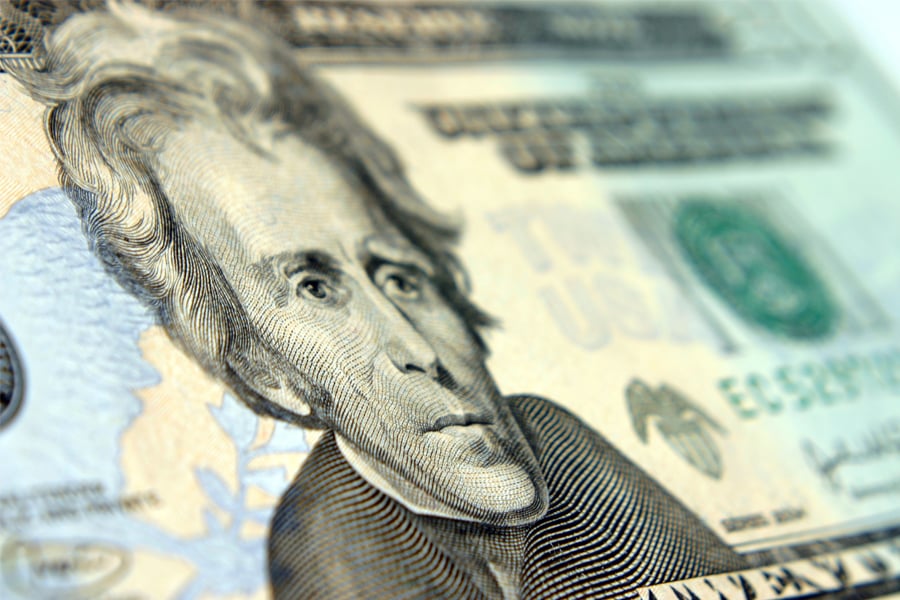America's seventh president will soon take a back seat to Harriet Tubman on the $20 bill. Based on his economic record, that may be where he belongs.
President Andrew Jackson, who will move from the front to the back of the $20 bill, was the hero of the Battle of New Orleans and a hard-core brawler — a man who nearly beat his would-be assassin to death.
As an economic leader, however, he presided over an enormous real estate bubble, saddling his successor with a massive banking collapse and a persistent deflationary recession. Sound familiar?
The move to replace the U.S.'s seventh president on the front of the $20 bill with former slave and abolitionist Harriet Tubman has predictably irked conservatives. After all, Mr. Jackson hated the Bank of the United States, the nation's first central bank, and closed it down. And he repaid every cent of the national debt. For conservative economists, this is the Holy Grail.
But one of the hallmarks of Mr. Jackson's term as president was a raging real estate bubble, which seems unusual, given the vast amount of sparsely populated territory in 1830s America. But, as with all manias, there was a reasonable explanation for soaring prices: Canals.
CANALS, ALL THE RAGE
Canals weren't exactly new technology — people have long known it's easier to drag things over water than land — but were all the rage in the 1830s, thanks to the success of the Erie Canal, which opened in 1825. Historian Gayle Olson-Raymer notes that the cost of shipping a ton of goods in upstate New York went from 19 cents a mile in 1820 to less than three cents a mile once the Erie Canal opened.
The U.S. canal system grew from 100 miles in 1816 to 3,300 miles in 1840 as states and corporations began looking at ways to link the Midwest to the East by water. And with that enthusiasm came two other side effects: Soaring land prices and soaring state debt.
Towns sprung up wherever a canal was planned, and land values in those towns soared. In hindsight, land was an obvious bubble. (Bubbles are always most apparent in hindsight.) “But, sir, the very fact that those surveys were made . . . made the people lose their mental balance; every neighborhood became so intoxicated with the idea that a railroad or canal was to pass near it, that the people became mad, as it were, and were unable to judge,” wrote Judge David Kilgore of the boom in Indiana land prices during the period.
States borrowed heavily for “internal improvements,” such as roads and canals. Mr. Jackson was ambivalent about them, but refused any undertaking that involved incurring federal debt — which meant most big projects. Instead, the states helped with their financing. In the case of Indiana, the state took on $10 million of debt for internal improvements at a time when the state's revenue was $75,000 a year. So as the U.S. was paying off its debts, the states were accumulating it massively.
Most of that borrowing came from Britain, where investors were eager to get higher yields from emerging markets debt — and in this case, the emerging market was the U.S. All told, the U.S. borrowed $200 million for internal improvements.
BANK OF THE UNITED STATES SHUTTERED
One of Mr. Jackson's signature policies was closing the Bank of the United States. He refused to reauthorize the bank in 1832. As the central bank wound down its operations, southern and western banks relaxed their lending standards, fueling the speculative fever in land.
To quench the real estate bubble, Mr. Jackson issued an executive order called the Specie Circular in 1836, that required that federal lands could only be bought with gold or silver coins. Because few could afford to pay cash on the barrelhead, land prices plummeted. At the same time, the Bank of England announced it would raise interest rates, drawing money away from the U.S.
Things went from bad to worse in 1837, by which point half the banks in the U.S. had failed completely or partially. And, because the central bank no longer existed, there was no lender of last resort. People began to horde cash, because in the days before federal deposit insurance, your life savings went away when your bank did. Interest rates rose as surviving banks also hoarded cash, and in New York, overnight rates soared from 5% to 24%.
Predictably, stock prices fell as land prices collapsed and businesses failed, with canal prices falling the fastest. By 1839, the nation was in a full-blown depression. In the following decade, states defaulted on their bonds for internal improvements: Indiana, for example, missed payments in 1841. Seven other states and Florida, then a territory, defaulted between 1839 and 1843. Arkansas, Florida, Louisiana, Michigan, and Mississippi repudiated all or part of their debt entirely.
The effects of the bursting of the Jacksonian bubble were felt for a long time afterwards. The U. S. and the individual states had difficulty borrowing for more than a decade afterwards. Martin Van Buren, who had ridden Jackson's coattails to the presidency, lost his bid for re-election. The nation didn't fully recover until the discovery of gold in California produced a spike in the money supply — and a burst of inflation.
Does Mr. Jackson deserve to remain on the $20 bill? It really depends on how you feel about him as a president, and you probably shouldn't judge him by 2016 standards. But if you're arguing for Mr. Jackson's record on the economy, he's probably best on the back, not the front, of the $20 bill.







